Dimerization Study guides, Revision notes & Summaries
Looking for the best study guides, study notes and summaries about Dimerization? On this page you'll find 55 study documents about Dimerization.
Page 4 out of 55 results
Sort by
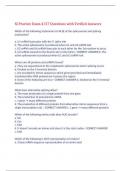
-
SI Practice Exam 4 |57 Questions with Verified Answers,100% CORRECT
- Exam (elaborations) • 14 pages • 2024
-
- £8.93
- + learn more
SI Practice Exam 4 |57 Questions with Verified Answers Which of the following statements is FALSE of the spliceosome and splicing mechanism? a. U1 snRNA base pairs with the 5' splice site b. The active spliceosome is produced when U1 and U3 snRNP exit c. U2 snRNA and U6 snRNA base pair to each other for the 1st reaction to occur d. U2 snRNA anneals to the branch site in the intron - CORRECT ANSWER b. The active spliceosome is produced when U1 and U3 snRNP exit Where are SR protein...
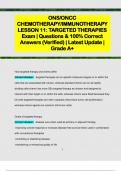
-
ONS/ONCC CHEMOTHERAPY/IMMUNOTHERAPY LESSON 11: TARGETED THERAPIES Exam | Questions & 100% Correct Answers (Verified) | Latest Update | Grade A+
- Exam (elaborations) • 12 pages • 2024
-
- £8.93
- + learn more
How targeted therapy and chemo differ Correct Answer: -targeted therapies act on specific molecular targets on or within the cells that are associated with cancer, whereas standard chemo act on all rapidly dividing cells-chemo has more SEs-targeted therapy ae chosen and designed to interact with their target on or within the cells, whereas chemo were IDed becaused they kill cells-targeted therapies are often cytostatic (they block tumor cell proliferation) whereas chemo agents are cyt...
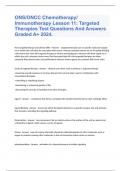
-
ONS/ONCC Chemotherapy/ Immunotherapy Lesson 11: Targeted Therapies Test Questions And Answers Graded A+ 2024.
- Exam (elaborations) • 7 pages • 2024
- Available in package deal
-
- £6.49
- + learn more
How targeted therapy and chemo differ - Answer -targeted therapies act on specific molecular targets on or within the cells that are associated with cancer, whereas standard chemo act on all rapidly dividing cells-chemo has more SEs-targeted therapy ae chosen and designed to interact with their target on or within the cells, whereas chemo were IDed becaused they kill cells-targeted therapies are often cytostatic (they block tumor cell proliferation) whereas chemo agents are cytotoxic (kill tum...
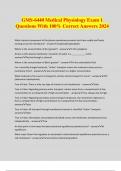
-
GMS-6440 Medical Physiology Exam 1 Questions With 100% Correct Answers 2024
- Exam (elaborations) • 23 pages • 2024
- Available in package deal
-
- £11.78
- + learn more
GMS-6440 Medical Physiology Exam 1 Questions With 100% Correct Answers 2024 What chemical component of the plasma membrane prevents ions from readily and freely moving across the membrane? - answerLipids (phospholipids) Where is the concentration of [K+] greater? - answerIn the cytoplasm Across a cell's plasma membrane, movemen of water is a ___________ event. - answerPassive through a channel. Where is the concentration of [Na+] greater? - answerIn the extracellular fluid. For a neutra...
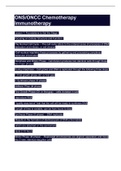
-
ONS/ONCC Chemotherapy Immunotherapy Certificate Study Guide Latest with complete solution
- Exam (elaborations) • 19 pages • 2023
-
- £10.15
- + learn more
ONS/ONCC Chemotherapy Immunotherapy Lesson 1: Foundations to Set the Stage - Focusing on Cellular Structure and Function - The Normal Cell Cycle - -The cell cycle refers to the ordered seres of processes of DNA replication and mitosis, or cell division -Cell nucleus regulates these processes by gathering and processing complexes molecular information Interphase and Mitotic Phase - Cell division produces two identical cells through these two major phases During interphase: -...
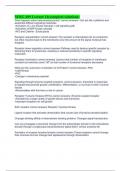
-
MMG 409 Lecture 14(complete solutions)
- Exam (elaborations) • 4 pages • 2024
- Available in package deal
-
- £8.85
- + learn more
What happens when beta-arresting binds? correct answers -Can act like a platform and assemble different signaling molecules -Activation of c-Jun kinase cascade = cell signaling path -Activation of MAP kinase cascade -AP2 and Clathrin - Endocytosis Receptor sequestration correct answers The receptor is internalized into an endosome but often recycles back to the membrane once the amount of the signal molecule has dropped. Receptor down-regulation correct answers Pathway used to destro...
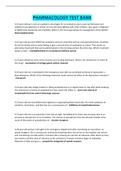
-
PHARMACOLOGY TEST BANK
- Exam (elaborations) • 20 pages • 2023
- Available in package deal
-
- £6.49
- + learn more
PHARMACOLOGY TEST BANK A 10-year old boy is sent to a pediatric neurologist for an evaluation due to poor performance and inability to pay attention in school. He has also been fighting with other children. He is given a diagnosis of ADHD with impulsivity and irratibility. Which is the most appropriate for management of the ADHD? - dextroamphetamine A 10-year-old boy with ADHD has symptoms that are controlled with an oral psychostimulant. However, he and his family wish to avoid having to give...
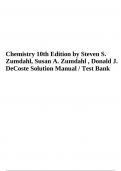
-
Chemistry 10th Edition by Steven S. Zumdahl, Susan A. Zumdahl , Donald J. DeCoste Test Bank
- Exam (elaborations) • 795 pages • 2023
-
- £36.98
- + learn more
The experimental rate law for the decomposition of nitrous oxide (N2O) to N2 and O2 is Rate = k[N2O]2 . Two mechanisms are proposed: I. N2O N2 + O N2O + O N2 + O2 II. 2N2O N4O2 N4O2 2N2 + O2 Which of the following could be a correct mechanism? A) Mechanism I, with the first step as the rate-determining step. B) Mechanism I, with the second step as the rate-determining step as long as the first step is a fast equilibrium step. C) Mechanism II, with the second step as the ra...
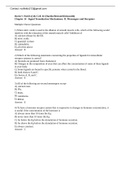
-
Becker's World of the Cell, 8e (Hardin/Bertoni/Kleinsmith) Chapter 14 Signal Transduction Mechanisms: II. Messengers and Receptors
- Exam (elaborations) • 12 pages • 2022
-
- £6.90
- + learn more
Becker's World of the Cell, 8e (Hardin/Bertoni/Kleinsmith) Chapter 14 Signal Transduction Mechanisms: II. Messengers and Receptors Multiple Choice Questions 1) When nitric oxide is used in the dilation of smooth muscle cells, which of the following would interfere with the relaxation of the smooth muscle cells? Inhibitors of A) calcium release by the ER. B) nitric oxide. C) guanylyl cyclase. D) calmodulin. E) all of the above Answer: E 2) Which of the following statements concerning the propert...
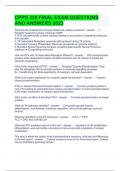
-
CPPS 325 FINAL EXAM QUESTIONS AND ANSWERS 2023
- Exam (elaborations) • 17 pages • 2023
- Available in package deal
-
- £15.44
- + learn more
CPPS 325 FINAL EXAM QUESTIONS AND ANSWERS 2023 What are the 5 well-known enzyme-linked cell surface receptors? 1. Receptor Guanylyl Cyclase: produces cGMP 2. RTK: phosphorylate tyrosine residues leading to association of signalling molecules and cascade 3. TK Associated Receptors: associate with proteins having TK activity 4. Receptor Tyrosine Phosphates: Removes phosphate on tyrosine residues 5. Receptor Serine/Threonine Kinases: phosphorylate specific Serine/Threonine residues on IC sign...



